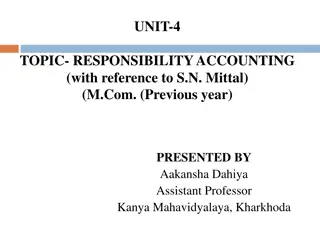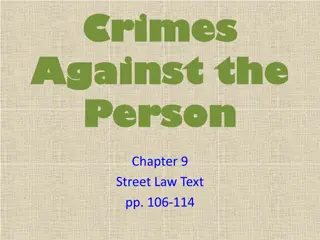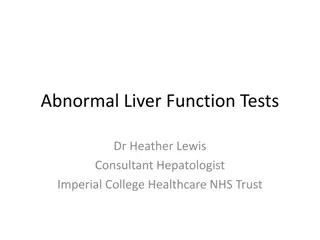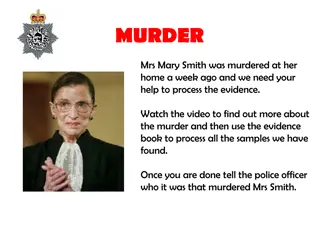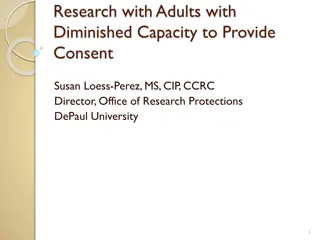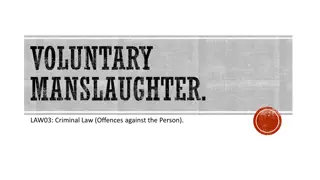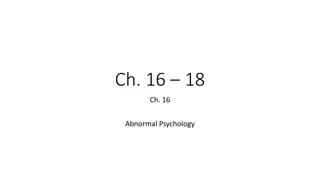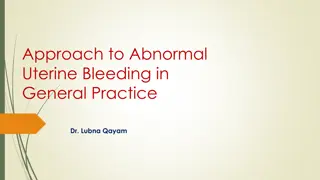Defences to Murder: Diminished Responsibility and Abnormal Mental Functioning
In cases of voluntary manslaughter, special defences like diminished responsibility and abnormal mental functioning can reduce a murder charge to manslaughter. Diminished responsibility under the Homicide Act 1957 involves proving an abnormality of mental functioning that substantially impairs the defendant's ability to understand the nature of their conduct or form rational judgments. The concept of abnormality of mental functioning, as discussed in Byrne (1960), covers a wide range of situations and must be proven on the balance of probabilities. The level of substantial impairment is a matter for the jury to decide based on medical evidence presented during the trial.
Download Presentation

Please find below an Image/Link to download the presentation.
The content on the website is provided AS IS for your information and personal use only. It may not be sold, licensed, or shared on other websites without obtaining consent from the author.If you encounter any issues during the download, it is possible that the publisher has removed the file from their server.
You are allowed to download the files provided on this website for personal or commercial use, subject to the condition that they are used lawfully. All files are the property of their respective owners.
The content on the website is provided AS IS for your information and personal use only. It may not be sold, licensed, or shared on other websites without obtaining consent from the author.
E N D
Presentation Transcript
Voluntary Manslaughter
Voluntary Manslaughter There are three special defences to a charge of murder: Diminished responsibility; Loss of control; or Suicide pact When one of these is successful the offence of murder is reduced to manslaughter
Diminished responsibility The defence is set out in s 2 (1) of the Homicide Act 1957 as amended by s 52 of the Corners and Justice Act 2009 The effect of this section is that: A person who kills or is a party to the killing of another is not to be convicted of murder if he was suffering from an abnormality of mental functioning which: (a) Arose from a recognised medical condition, (b) substantially impaired the defendant's ability to understand the nature of his conduct; or Form a rational judgment; or Exercise self-control and c) Provides an explanation for the defendant's acts omissions in doing or being a party to the killing The burden of proving the defence rests on the defendant, but it only needs to be proven on the balance of probabilities.
Abnormality of mental functioning Before s 52 of the Corners and Justice Act 2009 amended the definition of diminished responsibility, the phrase used was abnormality of mind - Byrne (1960) Although Byrne uses the old definition it is very likely that the courts will still use the same standard of abnormality, that is: that the defendant's mental functioning was so different that the reasonable man would find it abnormal the jury will decide this covers a wide range of situations: Seers (1985) chronic reactive depression. Hobson (1998) battered woman syndrome.
Substantially impaired Byrne (1960) the question of whether the impairment was substantial was one of degree and that it was for the jury to decide. Lloyd( 1967) substantial does not mean total. Seers (1984) Substantially means more than trivial but not total. Medical evidence will normally be given at trial which the jury can consider - Campbell (1997). Question will be withdrawn from the jury if there is no evidence of substantial impairment.
What must be substantially impaired? S 2 (1A) of the Homicide Act , the defendant s ability to do one of three things must be substantially impaired: To understand the nature of his conduct To form a rational judgement To exercise self-control - this was the case in Byrne (1960), medical evidence that his condition of being a sexual psychopath meant he was unable to control his perverted desires; the defence of diminished responsibility was therefore available to him. Since the Coroners and Justice Act 2009 there must now be some causal connection between the defendant s abnormality of mental functioning and the killing - s 2 (1B) Homicide Act 1957 1. 2. 3.
Diminished responsibility and intoxication Intoxication alone cannot support a defence of diminished responsibility, Di Duca (1959); Dowds (2012) Where the defendant has a pre-existing mental disorder, intoxication does not prevent him using the defence -If the condition existed before the intoxication it is acceptable even though the intoxication may have made it worse - Dietschmann (2003). Alcohol Dependency Syndrome can be an abnormality of mental functioning Wood (2008)
Reform of the law The Coroners and Justice Act 2009 new definition, using the phrase recognised medical condition , should be more flexible and allow for future developments in the field of medical science. The 2009 Act also now incorporates the decision in Byrne (1960) in that the Act sets out clearly what aspects of the defendant s mental functioning must be substantially impaired in order for the defence to succeed
Loss of control s.54 of the Coroners and Justice Act 2009. The defence of loss of control is a partial defence that may reduce liability for murder to manslaughter. It does not operate to absolve the defendant of liability completely. It is not a general defence and exists only for the offence of murder.
Loss of control The loss of control defence was introduced in response to concerns in relation to the defence of provocation. The defence of provocation proved problematic and was subject to much consideration by the appeal courts. The appeal courts were not always consistent in the interpretation and application .The defence was also considered to have a gender bias in that it was too favourable to those who killed as a result of losing their temper (generally male defendants) but did not provide a tailored response to those who kill out of a fear of serious violence (often women experiencing domestic violence). The extent to which the new legislation addresses these issues is a moot point. The new defence of loss of control is broadly similar to the defence of provocation in the requirements; however, it is far more restrictive in its application.
Loss of control The Ministry of Justice Impact Analysis of 2009 estimated that the changes would result in a further 10-20 murder rather than manslaughter convictions per year at a cost of 4-8M in the prison and court systems.
Loss of control Loss of self-control - There is no requirement that the loss of self- control be sudden (s. 54(2)). This represents a change from the law of provocation which required the loss of control to be sudden and temporary (R v Duffy) which was seen as a significant barrier to victims of domestic violence. See, R v Ahluwalia, R v Thornton; however, in each of those cases there was no loss of control, sudden or otherwise and thus the cases would have the same outcome under the new defence. The Law Commission had recommended that there should be no requirement of loss of control as this was the element of the defence of provocation that operated against women. cannot rely on the defence. This upholds the principle seen in R v Ibrams & Gregory By virtue of s. 54(4), if D acted in a considered desire for revenge they
Loss of control Qualifying trigger -Under the old law of provocation virtually any act was capable of being used as evidence of provocation. This was considered problematic in that it was too wide. The provocative action did not have to be deliberate or aimed at the victim, even a baby crying was accepted as a provocative act (R v Doughty). The introduction of qualifying triggers have narrowed the ambit of the new defence quite dramatically.
Loss of control The qualifying triggers are set out in s. 55 Coroners and Justice Act 2009. A qualifying trigger may only relate to: S.55 (3) Where the Defendant's loss of self-control was attributable to the Defendant's fear of serious violence from the Victim against the Defendant or another identified person. or S.55 (4) Where the Defendant's loss of self-control was attributable to a thing or things done or said (or both) which (a) constituted circumstances of an extremely grave character, and (b) caused D to have a justifiable sense of being seriously wronged. See the cases of Dawes (2013) and Zebedee (2012)
Loss of control The question of what constitutes circumstances of an extremely grave character and caused the defendant to have a justifiable sense of being seriously wronged is decided objectively: R v Hatter (2013) The breakdown of a relationship will not normally be regarded as circumstances of an extremely grave character nor entitle the aggrieved party to have a justifiable sense of being seriously wronged: R v Hatter (2013).
Loss of control Limitations on qualify triggers -Despite the restrictive wording used to establish a qualifying trigger, S. 55(6) Coroners and Justice Act 2009 provides two further limits as to what may be classed as a qualifying trigger. S.55(6)(a) The fact that a thing done or said constituted sexual infidelity is to be disregarded. S.55(6)(b) A person may not raise a qualifying trigger if they incited the thing done or said or the violence.
Loss of control Sexual infidelity -The limitation based on sexual infidelity represents a major change from the defence of provocation which was largely seen as an excuse for crimes of passion. This change is based on the view that in a civilised society there can be no excuse for killing due to infidelity. This provision has already been subject to interpretation by the Court of Appeal: R v Clinton (2012) in this case the defendant was suffering from depression and was taking medication for this. He killed his wife, the day before she had told him she was having an affair, she had taunted him and they had argued, he then killed her. He was convicted of murder but appealed on the basis that the defence of loss of control should have been left to the jury to decide. The Court of Appeal agreed and quashed his conviction - whilst sexual infidelity alone cannot amount to a qualifying trigger it does not have to be completely disregarded, it could be integral to and form part of other factors which could be qualifying triggers. In Dawes (2013) the Court of Appeal confirmed that sexual infidelity cannot amount to a qualifying trigger.
Loss of control Degree of tolerance and self-restraint -S.54(1)(c) requires that a person of the defendant's sex and age, with a normal degree of tolerance and self-restraint and in the circumstances of the defendant, might have reacted in the same or similar way. This is a question for the jury to decide. It replaces the reasonable man test which existed under the law of provocation which attracted widespread criticism and was subject to much conflicting interpretation in the courts culminating in the landmark case of Attorney General for Jersey v Holley [2005] .
Loss of control Reference to sex and age represents the position with regards to provocation established in DPP v Camplin [1978]. Problems with the reasonable man test related to the characteristics which could be attributed to the reasonable man. S.54(1)(C) makes explicit reference to just age and sex however, characteristics may be relevant when assessing the circumstances of the defendant although under s.54(3) circumstances which relate to the defendant's general capacity to exercise tolerance and self-restraint are to be disregarded. According to R v Clinton [2012] , sexual infidelity may be considered when looking at the circumstances under s.54(1)(c) in an appropriate case.
Loss of control and voluntary intoxication Voluntary intoxication is not a matter to be taken into account when considering the defendant's characteristics In Asmelash (2013) the Court of Appeal refused to allow the defendant's voluntary intoxication to be considered
Loss of control The defence of provocation required some degree of proportionality test in that the jury were required to assess the gravity of the provocation in deciding if a reasonable man would have done as the defendant did. The new defence of loss of control does not have such a balancing exercise. The gravity of the provocation, or trigger event, is assessed at stage two and must meet the specified thresholds of either fear of serious violence (s.55(3), extremely grave or seriously wronged (s.55(4). There is no requirement that this is weighed against the conduct of the defendant. Also rather than the jury assessing whether the provocation would have made a reasonable man do as the defendant did, the jury are required to consider if a relevant person might have reacted in the same or similar way. The third element of the defence, is thus perhaps more generous to defendants.








